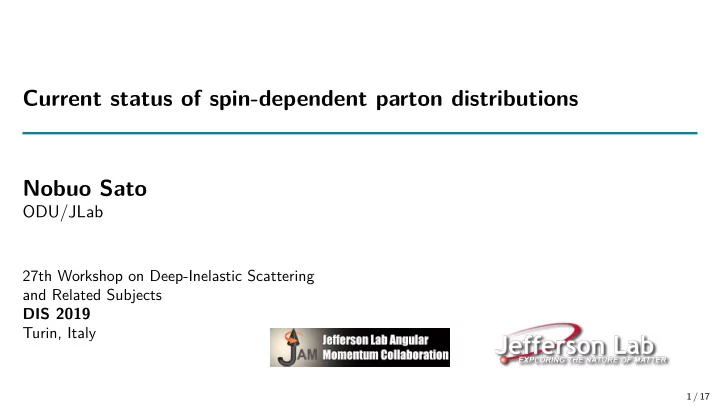

Current status of spin-dependent parton distributions Nobuo Sato ODU/JLab 27th Workshop on Deep-Inelastic Scattering and Related Subjects DIS 2019 Turin, Italy 1 / 17
2 / 17
2 / 17
“ Proton has spin 1/2 because it’s a fermion. Why need more explanation? ” Hatta 3 / 17
“ Proton has spin 1/2 because it’s a fermion. Why need more explanation? ” Hatta “ Spin crisis in the late 80’s ” 1 2 = 1 o Quark model of nucleon → 3 massive quarks 2∆Σ o Nucleon is in the ground state (s-state) → no OAM o Quarks expected to carry most of the nucleon’s spin 3 / 17
“ Proton has spin 1/2 because it’s a fermion. Why need more explanation? ” Hatta “ Spin crisis in the late 80’s ” 1 2 = 1 o Quark model of nucleon → 3 massive quarks 2∆Σ o Nucleon is in the ground state (s-state) → no OAM o Quarks expected to carry most of the nucleon’s spin But ∆Σ ≃ 0 . 28(4) JAM15 3 / 17
“ Proton has spin 1/2 because it’s a fermion. Why need more explanation? ” Hatta “ Spin crisis in the late 80’s ” 1 2 = 1 o Quark model of nucleon → 3 massive quarks 2∆Σ o Nucleon is in the ground state (s-state) → no OAM o Quarks expected to carry most of the nucleon’s spin But ∆Σ ≃ 0 . 28(4) JAM15 Ok ... QCD is more complicated: “ Spin crisis challenge ” 3 / 17
In terms of total angular momentum (GPDs): 1 2 = J q + J g 4 / 17
In terms of total angular momentum (GPDs): 1 2 = J q + J g In terms of spin (PDFs) and OAM: 1 2 = 1 2∆Σ + L q + ∆ g + L g 4 / 17
In terms of total angular momentum (GPDs): 1 2 = J q + J g In terms of spin (PDFs) and OAM: 1 2 = 1 2∆Σ + L q + ∆ g + L g Moments of helicity distributions 4 / 17
A big community working on the challenge 5 / 17
Small x asymptotics using large N c 6 / 17
Small x asymptotics using large N c 6 / 17
Small x asymptotics using large N c Kovchegov, Sievert, Pitonyak (’17) 6 / 17
OAM as a next-to-eikonal effect 7 / 17
OAM as a next-to-eikonal effect 7 / 17
OAM as a next-to-eikonal effect Hatta, Nakagawa, Xiao, Yuan, Zhao (’17) 7 / 17
Lattice QCD Alexandrou et al.,(ETMC) (’17) 1 2 = J q + J g Striped segments: → connected contributions Solid segments: → disconnected contributions 8 / 17
Lattice QCD: quasi-PDF 9 / 17
Lattice QCD: quasi-PDF ETMC 9 / 17
Lattice QCD: quasi-PDF ETMC ∆ ¯ ∆ ¯ d < ∆¯ u d > ∆¯ u 9 / 17
Global analyses 10 / 17
Valence polarization NS, Melnitchouk, Kuhn, Ethier, Accardi (’15) JAM15 MC sampling approach All ∆ DIS data with W 2 > 4 GeV 2 Constraints on twist-3 distributions No sign of ∆ d ( x ) /d ( x ) → 1 11 / 17
Gluon polarization De Florian, Sassot, Stratmann, Vogelsang (’14) p ↑ + p ↑ ( ↓ ) → j + X Single fit method + Lagrange 12 / 17
Gluon polarization De Florian, Sassot, Stratmann, Vogelsang (’14) p ↑ + p ↑ ( ↓ ) → j + X � 1 dx ∆ g ( x ) = 0 . 013 + 0 . 702 − 0 . 314 Single fit method + Lagrange 0 . 001 12 / 17
Light sea polarization p ↑ + p → W ± → e ± + ν + X 13 / 17
Light sea polarization Nocera (’17) p ↑ + p → W ± → e ± + ν + X NNPDF Reweighting 13 / 17
Light sea polarization 14 / 17
Light sea polarization Xu (spin 18) u > ∆ ¯ ∆¯ d 14 / 17
Strange polarization Most of existing analysis on ∆ PDFs used additional constraints � 1 0 dx (∆ u + − ∆ d + ) = g A Neutron decay → � 1 0 dx (∆ u + + ∆ d + − 2∆ s + ) = g 8 Hyperon decay → ∆ s + puzzle g 8 ? ∆ SIDIS ( ¯ s → K FF)? fiction? 15 / 17
Strange polarization Ethier, NS, Melnitchouk (’17) Current ∆ SIDIS unable to discriminate strange polarization No conflict between the ∆ DIS and ∆ SIDIS A combined ( ∆ )PDF & FF is needed 16 / 17
Summary and outlook From spin crisis to spin challenge: → a growing community exploring QCD From global analysis to universal analysis: → TMDs, GPDs From single fits to MC methods: → a paradigm shift 17 / 17
Recommend
More recommend